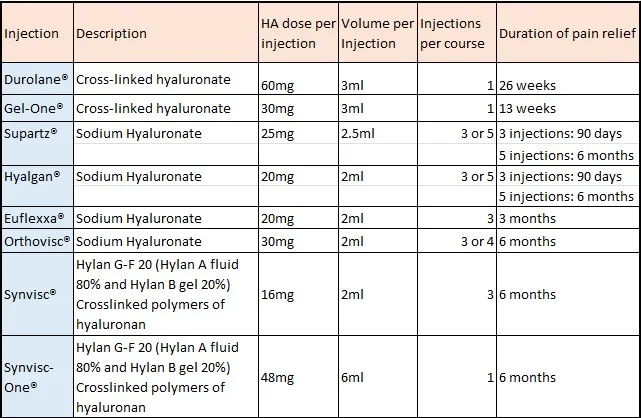Talk with Your Doctor Today
Choose Dr. Morton to help you Get your Gel Injection
- Experienced Orthopedic Surgeon
- Nonoperative and operative treatments available
- High success rate in providing joint injections
- Excellent nonoperative treatments for arthritis available
- Well-versed with modern techniques
- Evidence-based injections, not driven by industry and marketing
- Fellowship-trained in joint replacements
- Platelet Rich Plasma (PRP)
- Steroid Injections
- Hyaluronic Acid (gel) Injections
- Ultrasound guided
- Alternatives to Knee and Hip Replacement
What is hyaluronic acid?
Hyaluronic acid (HA) or Hyaluronate is a naturally-occurring substance that’s ubiquitously found in the body. HA is a glycosaminoglycan that’s part of the connective tissue, which consists of carbohydrates known as polysaccharides.
In the past few years, the popularity of these types of injections using HA skyrocketed. A simple procedure that involves injecting HA into your joint can significantly relieve your suffering.
Other names for hyaluronic acid injections include:
“Gel Shots” refers to the consistency and similarity to the fluid that is already in your joints.
“Chicken” or “Rooster shots” which refers to the original method of extraction of hyaluronic acid from rooster combs.
In this article, we will discuss the benefits of using hyaluronic acid injections and how they could improve your joint pain.
The hype behind hyaluronic acid
Over the past few years, hyaluronic acid gained massive popularity in the field of pain relief, as it’s advertised to relieve joint pain and improve its mobility.
The use of hyaluronic acid is common when corticosteroid injections are ineffective. Additionally, patients who have joint pain and diabetes may benefit from gel injections since corticosteroids can raise blood sugar levels.
When you have osteoarthritis, the synovial fluid found inside your joints becomes watery. As a result, the friction between your bones is more prominent. Using gel injections restores the natural properties of the synovial fluid, which helps it lubricate and absorb shocks.
In simpler terms, HA acts as a cushion or a better one that neutralizes the overactivation of inflammatory cells inside your joints. It can also stimulate the cells of your joint to start producing natural HA.
Hyaluronic acid may provide methods of relief beyond just mechanical. These HA injections may decrease inflammation and desensitize nerves by coating nerve endings inside the joint.
Studies found hyaluronic acid supplements improve different joint pain shortly after injection. Unfortunately, many of the published studies lack high epidemiological standards, which questions the credibility of the findings. Moreover, one meta-analysis found only a mild reduction in pain after receiving HA injections.
The problem with these studies is that it includes multiple formulations of hyaluronic acid and multiple dosing regimens. Some HA formulations consist of a higher molecular weight, while some formulations have lower molecular weight. The higher the molecular weight, the longer the chain of hyaluronic acid is, which in theory will allow for a longer-lasting molecule. Gel-one and the Synvisc formulations are cross-linked hyaluronic acid, which may create a more stable molecule. Durolane is a formulation that allows a high concentration of cross-linked hyaluronic acid into a single injection.
The table included below may provide some information on the dosing amount and number of injections as well as the consistency of each brand of injection available.

Studies Evaluating Durolane Compared to Steroid or other Gel-injections
41% lower VAS pain score at 6 months compared to Synvisc One
79% of Durolane treated patients experienced improved pain control for 26 weeks.
Compared to steroid injections, pain relief lasts 2x long
41% lower VAS pain score at 6 months compared to Synvisc One
79% of Durolane treated patients experienced improved pain control for 26 weeks.
Compared to steroid injections, pain relief lasts 2x long
Durolane® Single-injection Knee Treatment
Durolane is a transparent, sterile, viscoelastic hydrogel approved for the treatment of pain in osteoarthritis of the knee. In Durolane, hyaluronan strands have unique cross-linking and are attached to each other through dimmers of cinnamic acid that results in increased viscoelasticity. This helps to relieve pain and improves the functioning of the knee.
Hyaluronan is found in synovial joints naturally in high amounts. it acts like a shock absorber and lubricant in the joint for it to function properly.
A highly purified 3 ml single injection, Durolane delivers a complete treatment. Durolane offers the following benefits.
- Safe & effective treatment
- Single-injection with fewer office visits
- Supplement the cushioning and lubrication in the knee joint
How Durolane works
Durolane is a transparent gel made from sodium hyaluronate (hyaluronan). This substance is naturally occurring in synovial joints, as it acts as a lubricant and shock absorber.
One study found that hyaluronic acid injections provide pain relief from osteoarthritis for up to 26 weeks. The effect could last for one year.
The term viscosupplementation, or knee shot, refers to treating osteoarthritis (OA) of the knee with direct injection of sodium hyaluronate. This technique relieves OA-associated pain.
While there are several forms of viscosupplementation in the U.S. market, Durolane offers a convenient single injection with only 3 mL. On the other hand, other brands require larger doses and multiple injections, which may be quite inconvenient.
In general, one therapeutic session (1 injection) may be enough to relieve your symptoms for up to one year.
Durolane’s unique cross-linked structure showed greater viscoelasticity among other brands, which leads to better durability and resistance. This product is simply more resistant to breakdown than other HA solutions.
Procedure:
Apply antiseptic or local anesthesia if needed to the knee joint. Access the knee joint space via the soft palpable anterolateral port placed lateral to the inferior pole of the patella. Remove the joint effusion via an 18-20 gauge needle prior to gel injection. Remove the syringe tip and secure the needle tightly. Twist the tip cap to minimize leakage and then inject 3 ml of gel into the knee joint. A separate syringe is used if you are administering the gel injections for both knees.
In summary, here are the potential benefits of gel injections with hyaluronic acid:
- HA possesses anti-inflammatory and antioxidative properties that combat the buildup of harmful chemicals inside the joint.
- By increasing the joint’s natural abilities to regenerate, HA can be an effective substance at decreasing the pain from osteoarthritis.
- HA lubricates the synovial fluid and helps it restore its natural properties, which reduces the impact of friction and osteolysis (i.e., bone destruction).
What does the procedure involve?
In general, you can receive a gel injection at the doctor’s office. The procedure only takes a few minutes.
Your doctor will place the affected joint in position while using an ultrasound to guide the needle to the best location.
Here are the steps to expect during this procedure:
- Cleaning the skin around the skin and applying local anesthesia
- Inserting the needle into your joint
- Injecting HA inside your joint
While you may feel some discomfort when the needle gets inserted, the procedure is not painful. In addition to injecting HA, your doctor may remove a small amount of your synovial fluid to reduce intraarticular pressure.
Once the fluid is removed, it’s time to inject the HA solution.
Recovery from the procedure
Receiving an HA injection will not affect your ability to walk. Usually, you can go home briefly after receiving the treatment.
Here are some tips to optimize your recovery:
- Avoid strenuous activity for the next 24 hours
- Do not go swimming
- Avoid hot tubs
- Do not expose yourself to substances or solutions that may cause your joint to get infected through the needle track (it generally closes up within 24 hours)
- Take OTC painkillers to reduce discomfort
When can I expect pain relief?
Naturally, every patient responds differently to hyaluronic acid injections. Depending on factors, such as your medical history, the severity of pain, and other factors, you can experience different rates of pain relief.
According to one study, researchers found that the average person reports significant pain relief in as little as 3 weeks after getting the Gel-One injection.
Hyaluronic acid side effects
Side effects of hyaluronic acid include:
- Pain
- Redness
- Itching
- Swelling
- Bruising
The side effects listed above are usually the result of the injection itself rather than the hyaluronic acid solution.
Once your joint absorbs the substance, you may experience the typical side effects of an allergy. According to research, a hyaluronic acid-mediated allergic reaction is quite rare; however, individuals with a medical history of severe hypersensitivity reactions and anaphylaxis must be cautious before getting the injection. These reactions are less common with a stable molecule like that found in gel-one.
Hyaluronic acid can also interfere with wound healing, which gets mediated by fibroblasts and collagen fibers. According to one study, applying HA topically slows down the process of wound healing compared to using pure glycerin.
One extremely rare side effect is pseudosepsis, which describes a set of symptoms that resemble an infected joint. Such symptoms might include fever, severe pain, and inability to ambulate. If this occurs, call your physician to make sure that your symptoms do not warrant further emergent workup.
Additionally, using HA during pregnancy and breastfeeding is not confirmed to be safe. Therefore, women should avoid getting HA injections during these times.
Takeaway message
Hyaluronic acid is a common substance used in different pain relief products.
Hopefully, this article managed to shed some light on the potential uses of hyaluronic acid in relieving joint pain.
https://www.youtube.com/watch?v=I-ENVDMzMJ4
If you still have any unanswered questions about HA, please don’t hesitate to set up a consult with Dr. Morton today!

